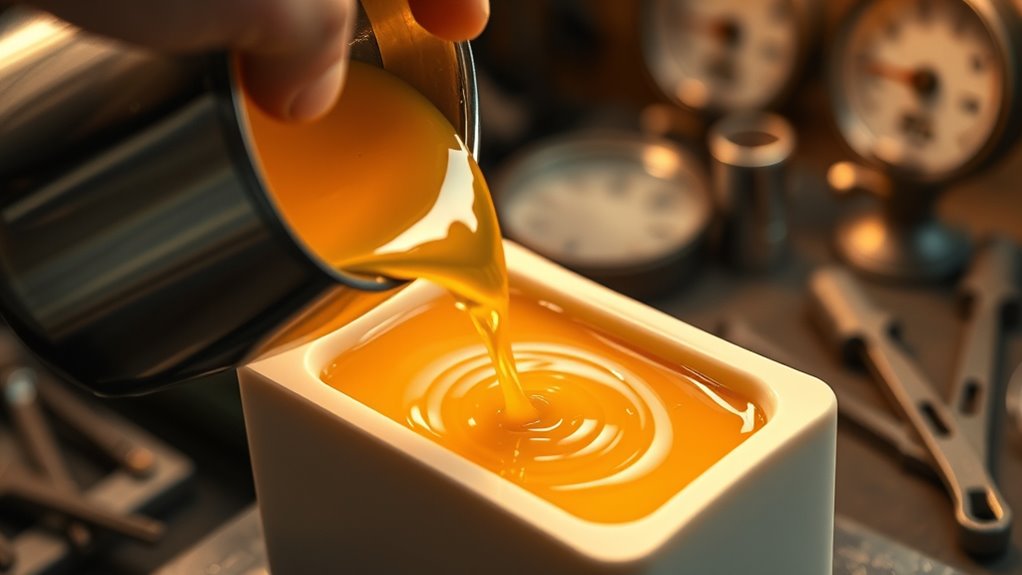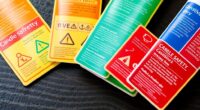To fix first-pour frustration, focus on mastering wax temperatures quickly. Use a reliable thermometer to monitor your wax as it melts—most waxes need to be heated gradually to the right temperature, usually between 150-160°F for soy. Consistently maintain this range for smooth pours and a professional finish. If you keep precise control and stay within these temps, your candles will turn out flawless. Continue exploring these tips to become confident in achieving perfect wax consistency every time.
Key Takeaways
- Use a reliable thermometer to monitor wax temperature continuously during melting and pouring.
- Know your wax’s ideal pouring temperature (e.g., soy wax between 150°F-160°F) for best results.
- Gradually heat wax and avoid rushing to prevent overheating or underheating.
- Stir gently and evenly to maintain consistent temperature and texture.
- Pour at the recommended temperature to achieve smooth, flawless candles and prevent surface imperfections.

Understanding and controlling wax temperatures is essential for achieving perfect results in candle making. When you get the temperature control right, you’ll notice a significant difference in how your candles turn out. It’s not just about melting the wax; it’s about reaching the precise temperature that ensures ideal wax consistency. This consistency affects how smoothly your wax pours, how well it holds fragrance, and how evenly it sets. If your wax is too hot or too cold, you’ll likely face issues like sinkholes, cracks, or uneven surfaces. That’s why mastering wax temperatures is the key to consistent, professional-looking candles.
Mastering wax temperature is key for flawless, professional-looking candles.
To start, you need to recognize the importance of monitoring your wax’s temperature closely throughout the process. Use a reliable thermometer, preferably an infrared or digital probe, to keep an eye on the temperature as you melt your wax. Every wax type, whether soy, beeswax, or paraffin, has its ideal pouring temperature range. For example, soy wax typically melts at around 170°F and should be poured between 150°F and 160°F for the best finish. Beeswax, on the other hand, has a different range. Knowing these specifics helps you adjust heat so that the wax maintains the right consistency for pouring.
Achieving the perfect wax consistency hinges on proper temperature control. When wax is heated too high, it can become overly fluid, making it difficult to control during pouring and increasing the risk of cracks or surface imperfections. Conversely, if the wax isn’t heated enough, it thickens and becomes difficult to pour smoothly, leading to an uneven surface or trapping air bubbles. The secret is bringing the wax to the ideal temperature, then maintaining it just below that point until you’re ready to pour. This way, your wax remains fluid enough for a clean, even pour, but not so hot that it causes problems.
Another tip is to adjust your heat source gradually, rather than rushing the melting process. Use a double boiler or a controlled melting pot to keep temperatures stable. Stir your wax gently as it melts to promote even heat distribution, which helps maintain consistent wax temperature and wax consistency. Before pouring, let the wax sit for a few moments at the target temperature. This pause allows heat to distribute evenly, preventing temperature fluctuations that can compromise your candle’s appearance. Additionally, understanding the ideal pouring temperature for your specific wax type can greatly improve your candle’s finish.
Frequently Asked Questions
Can I Reuse Wax After It Cools Down?
You can reuse wax after it cools down, but it’s important to consider wax reuse carefully. Cooling wax may change its texture or effectiveness, so you should inspect it for impurities or hardened spots before reheating. Reusing wax is common, but ensure you clean it properly and reheat it to the correct temperature. Proper handling guarantees smooth results and prevents waste, making your waxing sessions more efficient and cost-effective.
What Safety Precautions Are Necessary When Melting Wax?
When melting wax, safety is your priority. Think of ventilation safety as your shield against fumes, ensuring good airflow. Always wear protective gear like gloves and goggles to prevent burns and splashes. Keep a fire extinguisher nearby, and work in a well-ventilated area. These precautions protect you from hazards, making your melting process safe and smooth, so you can focus on creating without worry.
How Do Different Wax Types Affect Temperature Control?
Different wax types affect temperature control because their wax consistency and melting points vary. You need to monitor each wax’s melting point closely, as softer waxes melt at lower temperatures, while harder waxes require higher heat. By understanding these differences, you can prevent overheating or under-melting, ensuring your wax remains at the ideal temperature for a smooth pour and perfect finish. Adjust your heat accordingly for each wax type.
Is There a Risk of Fire When Heating Wax?
Heating wax does carry fire hazards if not managed carefully. You should always monitor the temperature closely and avoid overheating, as wax can catch fire if it gets too hot. Follow safety tips like using a double boiler, keeping a fire extinguisher nearby, and never leaving the heat source unattended. These precautions help prevent accidents and ensure your wax heating process remains safe and controlled.
How Often Should I Check the Wax Temperature During Heating?
You should check the wax temperature frequently during heating, ideally every few minutes. Place your thermometer properly in the wax, making sure it’s not touching the sides or bottom of the pot for accurate readings. Keep an eye on the heating duration, and don’t leave it unattended. Regular checks help prevent overheating and ensure you reach the perfect temperature safely and efficiently, making your wax pouring process smooth and frustration-free.
Conclusion
Now that you’ve uncovered the secret to perfect wax temperatures, you’re like a skilled artist wielding a fiery brush. With just 15 minutes of practice, you’ll tame the molten beast, transforming chaos into smooth, glossy perfection. Your confidence will soar as you navigate each pour with the precision of a master. So, embrace the heat, trust your instincts, and turn every wax session into a masterpiece—you’re well on your way to waxing wizardry.










